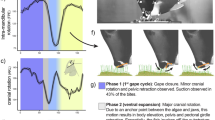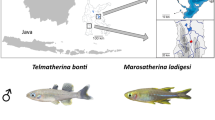Abstract
Teleost fishes capture prey using ram, suction, and biting behaviors. The relative use of these behaviors in feeding on midwater prey is well studied, but few attempts have been made to determine how benthic prey are captured. This issue was addressed in the wrasses (Labridae), a trophically diverse lineage of marine reef fishes that feed extensively on prey that take refuge in the benthos. Most species possess strong jaws with stout conical teeth that appear well-suited to gripping prey. Mechanisms of prey capture were evaluated in five species encompassing a diversity of feeding ecologies: Choerodon anchorago (Bloch, 1791), Coris gaimard (Quoy and Gaimard, 1824), Hologymnosus doliatus (Lacepède, 1801), Novaculichthys taeniourus (Lacepède, 1801) and Oxycheilinus digrammus (Lacepède, 1801). Prey capture sequences were filmed with high-speed video at the Lizard Island Field Station (14°40′S, 145°28′E) during April and May 1998. Recordings were made of feeding on pieces of prawn suspended in the midwater and similar pieces of prawn held in a clip that was fixed to the substratum. Variation was quantified among species and between prey types for kinematic variables describing the magnitude and timing of jaw, hyoid, and head motion. Species differed in prey capture kinematics with mean values of most variables ranging between two and four-fold among species and angular velocity of the opening jaw differing seven-fold. The kinematics of attached prey feeding could be differentiated from that of midwater captures on the basis of faster angular velocities of the jaws and smaller movements of cranial structures which were of shorter duration. All five species used ram and suction in combination during the capture of midwater prey. Surprisingly, ram and suction also dominated feedings on attached prey, with only one species making greater use of biting than suction to remove attached prey. These data suggest an important role for suction in the capture of benthic prey by wrasses. Trade-offs in skull design associated with suction and biting may be particularly relevant to understanding the evolution of feeding mechanisms in this group.
Similar content being viewed by others
References
Alfaro M, Westneat MW (1999) Motor patterns of herbivorous feeding: electromyographic analysis of biting in the parrotfishes Cetoscarus bicolor and Scarus iseri. Brain Behav Evol 54:205–222
Bellwood DR, Choat JH (1990) A functional analysis of grazing in parrotfishes (family Scaridae): the ecological implications. Environ Biol Fish 28:189–214
Cook A (1996) Ontogeny of feeding morphology and kinematics in juvenile fishes: a case study of the cottid fish Clinocottus analis. J Exp Biol 199:1961–1971
Ferry-Graham LA, Lauder GV (2001) Aquatic prey capture in ray-finned fishes: a century of progress and new directions. J Morphol 248:99–119
Ferry-Graham LA, Wainwright PC, Westneat MW, Bellwood DR (2001) Modulation of prey capture kinematics in the cheeklined wrasse Oxycheilinus digrammus (Teleostei: Labridae). J Exp Zool 290:88–100
Graham MH, Edwards MS (2001) Statistical significance vs. fit: estimating the importance of individual factors in ecological analysis. Oikos 93: 505–513
Gregory WK (1933) Fish skulls: A study of the evolution of natural mechanisms. Trans Am Phil Soc XXIII: 75–481
Grubich JR, Wainwright PC (1997) Motor basis of suction feeding performance in largemouth bass, Micropterus salmoides. J Exp Zool 277:1–13
Hiatt RW, Strasburg DW (1960) Ecological relationships of the fish fauna on coral reefs of the Marshall Islands. Ecol Monogr 30:65–127
Hobson ES (1974) Feeding relationships of teleostean fishes on coral reefs in Kona, Hawaii. Fish Bull 72:915–1031
Kaufman LS, Liem KF (1982) Fishes of the suborder Labroidei (Pisces: Perciformes): phylogeny, ecology, and evolutionary significance. Brevioria 472:1–19
Liem KF (1979) Modulatory multiplicity in the feeding mechanism in cichlid fishes, as exemplified by the invertebrate pickers of Lake Tanganyika. J Zool Soc 189:93–125
Liem KF (1990) Aquatic versus terrestrial feeding modes: possible impacts on the trophic ecology of vertebrates. Am Zool 30:209–221
Muller M, Osse JWM, Verhagen JHG (1982) A quantitative hydrodynamical model of suction feeding in fish. J Theor Biol 95:49–79
Nelson JS (1994) Fishes of the World, 3rd edn. Wiley, New York
Nemeth DH (1997) Modulation of buccal pressure during prey capture in Hexagrammos decagrammus (Teleostei: Hexagrammidae). J Exp Biol 200:2145–2154
Norton SF (1991) Capture success and diet of cottid fishes: the role of predator morphology and attack kinematics. Ecology 72:1807–1819
Norton SF (1995) A functional approach to ecomorphological pattern of feding in cottid fishes. Environ Biol Fish 44:61–78
Norton SF, Brainerd EL (1993) Convergence in the feeding mechanics of ecomorphologically similar species in the Centrarchidae and Cichlidae. J Exp Biol 176:11–29
Randall JE (1967) Food habits of the reef fishes of the West Indies. Stud Trop Oceanogr 5:665–847
Randall JE, Allen GR, Steene RC (1990) Fishes of the Great Barrier Reef and Coral Sea. Crawford House, Bathurst, NSW, Australia
Rice WR (1989) Analyzing tables of statistical tests. Evolution 434:223–225
Rognes K (1973) Head skeleton and jaw mechanism in Labrinae (Teleostei: Labridae) from Norwegian waters. Arbok Univ Bergen Mat Naturvitensk Ser:1–149
Sanderson SL (1990) Versatility and specialization in labrid fishes: Ecomorphological implications. Oecologia 84:272–279
Tedman RA (1980) Comparative study of the cranial morphology of the labrids Choerodon venustus and Labroides dimidatus and the scarid Scarus fasciatus (Pisces: Perciformes) I. Head skeleton. Aust J Mar Freshw Res 31:337–349
Wainwright PC, Bellwood DR (2002) Ecomorphology of feeding in coral reef fishes. In: Sale PF (ed) Coral reef fishes. Dynamics and diversity in a complex ecosystem. Academic Press, San Diego, pp 33–55
Wainwright PC, Lauder GV (1986) Feeding biology of sunfishes: patterns of variation in the feeding mechanism. Zool J Linn Soc 88:217–228
Wainwright PC, Richard BA (1995) Predicting patterns of prey use from morphology of fishes. Environ Biol Fish 44:97–113
Wainwright PC, Shaw SS (1999) Morphological basis of kinematic diversity in feeding sunfishes. J Exp Biol 202:3101–3110
Wainwright PC, Westneat MW, Bellwood DR (2000) Linking feeding behavior and jaw mechanics in fishes. In: Domenici P, Blake R (eds) Biomechanics in animal behavior. BIOS Scientific, Oxford, pp 207–221
Wainwright PC, Ferry-Graham LA, Carroll AM, Hulsey CD, Waltzek TB, Grubich JR (2001) Evaluating the use of ram and suction during prey capture in cichlid fishes. J Exp Biol 204:3039–3051
Westneat MW (1990) Feeding mechanics of teleost fishes (Labridae; Perciformes): A test of four-bar linkage models. J Morphol 205:269–295
Westneat MW (1991) Linkage biomechanics and evolution of the unique feeding mechanism of Epibulis insidiator (Labride: Telesotei). J Exp Biol 159:165–184
Westneat MW (1994) Transmission of force and velocity in the feeding mechanisms of labrid fishes. Zoomorphology 114:103–118
Westneat MW (1995) Feeding, function, and phylogeny: analysis of historical biomechanics in labrid fishes using comparative methods. Syst Biol 44:361–383
Westneat MW, Wainwright PC (1989) Feeding mechanism of Epibulus insidiator (Labridae; Teleostei): Evolution of a novel functional system. J Morphol 202:129–150
Zar JH (1984) Biostatistical analysis. Prentice-Hall, Englewood Cliffs, N.J.
Author information
Authors and Affiliations
Corresponding author
Additional information
Communicated by J.P. Grassle, New Brunswick
Published online: 11 July 2002
Rights and permissions
About this article
Cite this article
Ferry-Graham, L.A., Wainwright, P.C., Westneat, M.W. et al. Mechanisms of benthic prey capture in wrasses (Labridae). Marine Biology 141, 819–830 (2002). https://doi.org/10.1007/s00227-002-0882-x
Received:
Accepted:
Issue Date:
DOI: https://doi.org/10.1007/s00227-002-0882-x




